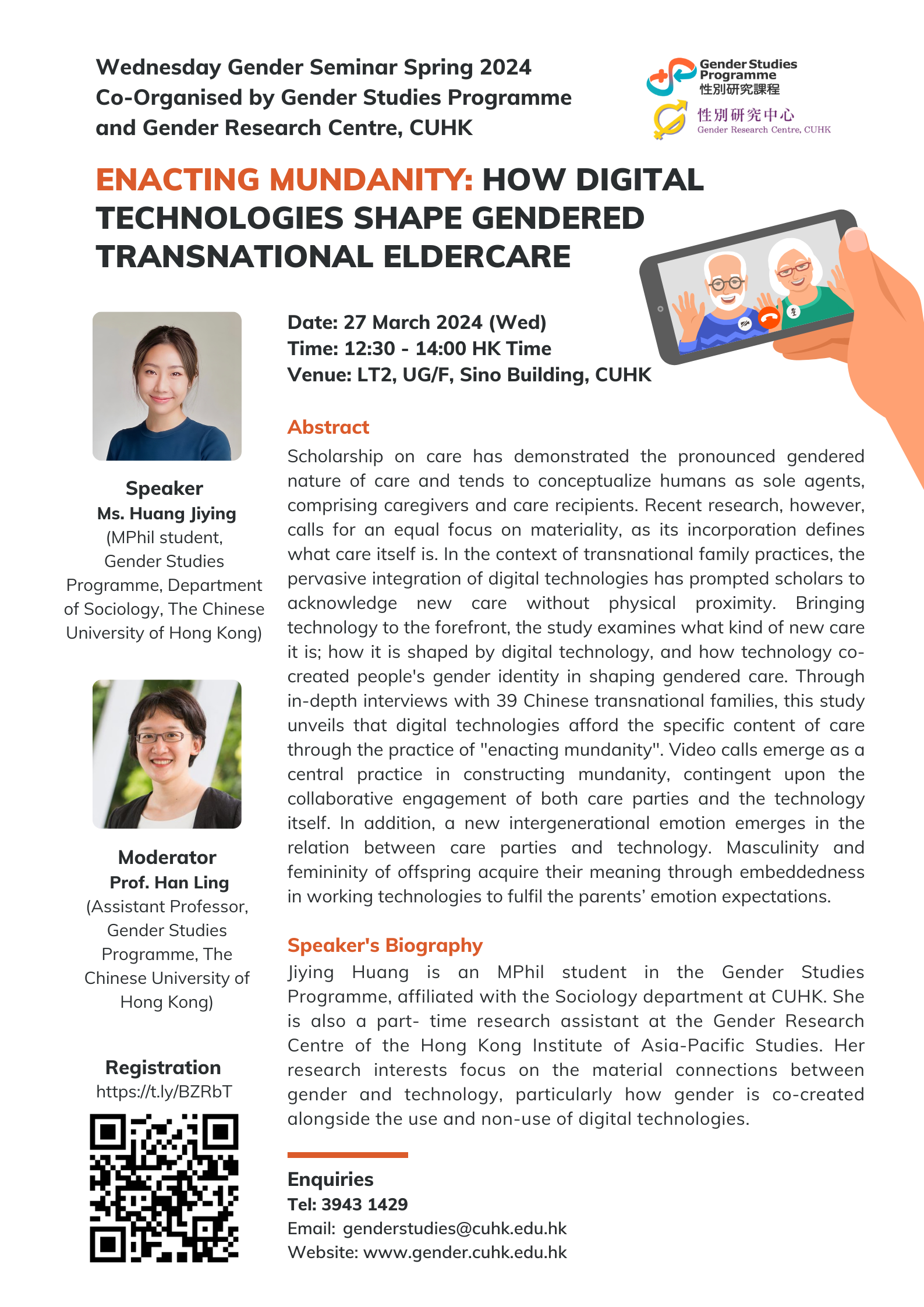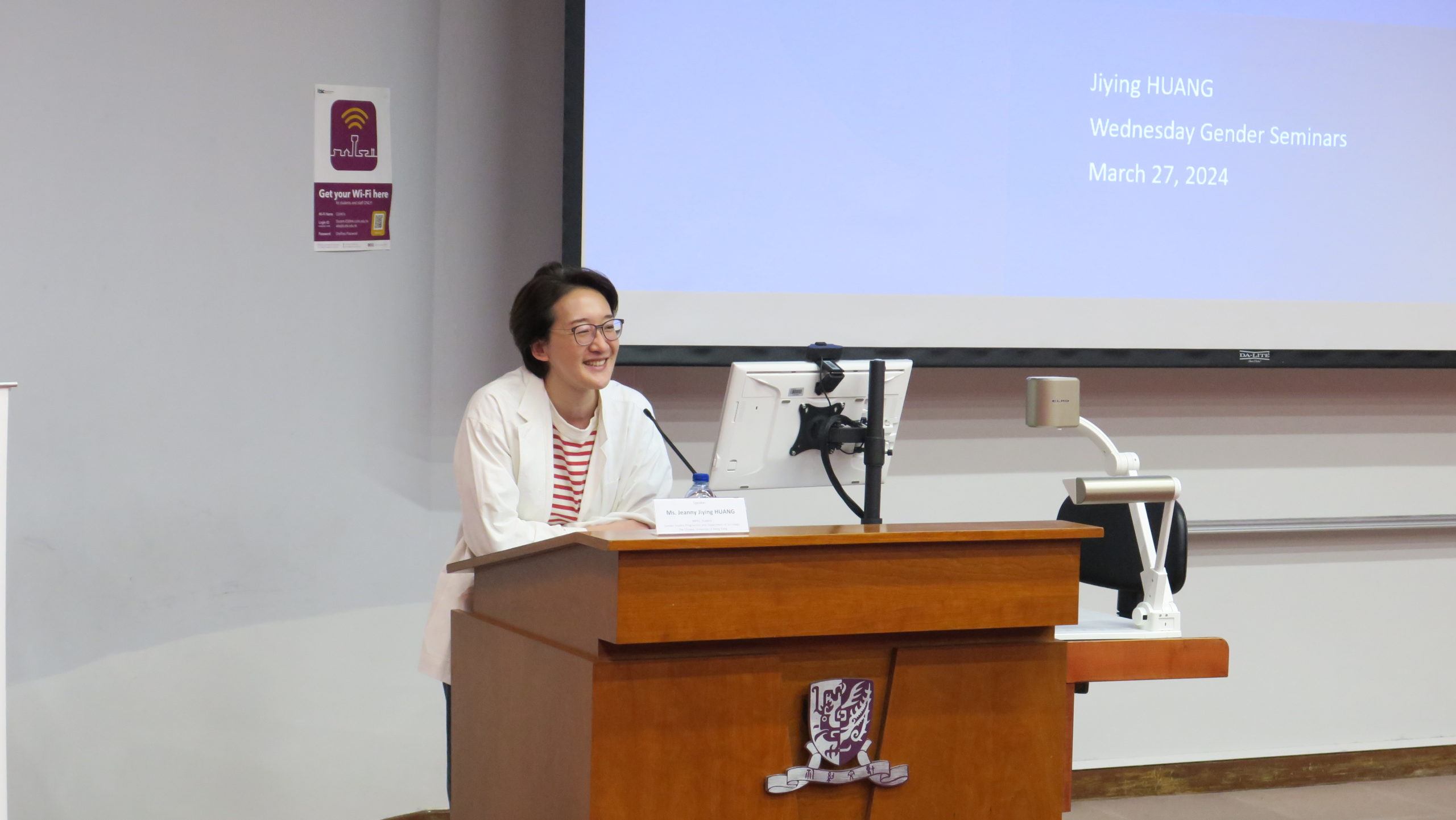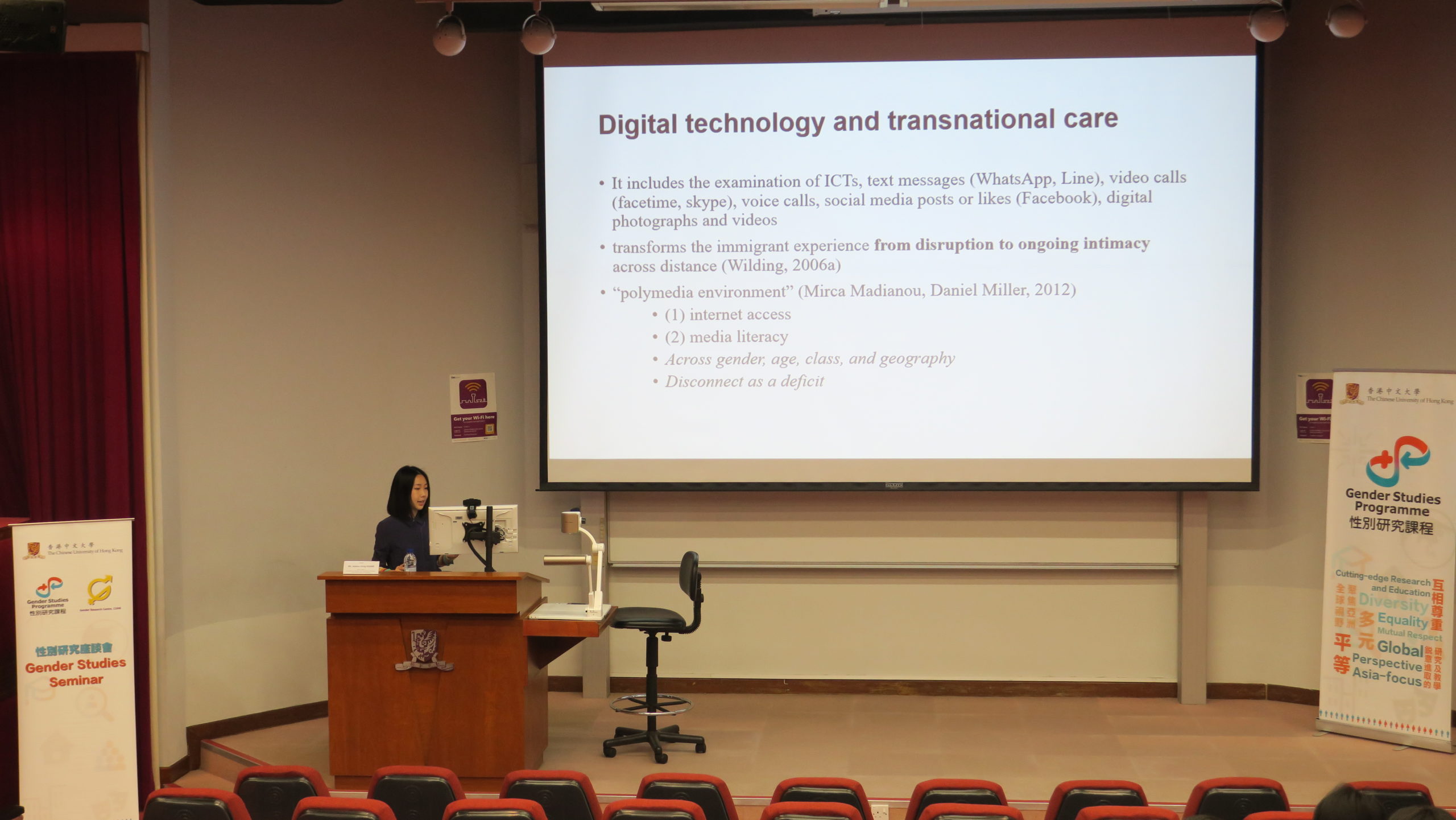The speaker Jeanny Jiying HUANG shared the theoretical approach of her research at the beginning, that is, digital technologies seen as ‘finished’ or ‘ready-made’ entities are relatively undertheorized in transnational family research whereas the transparent technology is engaged in many relations. Thus the researcher proposed three research questions:
l How do people perceive transnational care?
l How do people and technology co-operate to make care exist as they understand it?
l How are gender and technology mutually shaped in transnational care practices?
The study employed remote in-depth interviews to collect data from 39 transnational families in China. To answer the first research question, the researcher found that caring is immigrant adult children’s selection of what to care about and what to care about is the cooperation with people and digital technology. The researcher also mentioned that class plays an important role in the case of transnational elder care. For example,people perceive to care about emotional rather than financial condition. As a result, the technology focuses on and facilitates the demand for emotions and for sharing everydayness. Such demands equalize the expectations of gender roles and shape the way transnational children become good sons and daughters. As for the gender practice, men are more likely to communicate with their fathers, while women become dominant in communicating with their mothers. Another important finding is that because the lens of a video phone limits the range of what a person can observe, presence and absence can be emphasised, blurred, or even hidden by adjusting the lens. As a consequence, even when both parents are in the same space at the same time, the frequency of their “presence” on camera is not equal.
Written by: WANG, Xiaoqing
Today’s topic is about how do transnational family doing caretaking and elder caretaking. Congressional family means the parents are left behind in the home country while their daughter and son are migrants in the host country. Recent years, within the development about the digital technology, there is a significant involvement in the digital technology in the transnational family. It includes the examination of ICTs, text messages, video calls, voice calls, social media posts or likes, digital photographs and videos. These digital technology transforms the immigrant experience from disruption to ongoing intimacy across distance.
The speaker uses doing gender theory in her article, which is, gender is an achievement, it is a situated doing, an emergent feature of social situations formed along the way. Her research questions are as follows. How do people perceive transnational care? How do people and technology co-operate to make care exist as they understand it? How are gender and technology mutually shaped in transnational care practices? This study employs remote in-depth interviews to collect data from 39 transnational families in China. All interviews were based on a semi-structed interview protocol that lasted between 50 minutes to 3 hours.
Within-country caregiving is categorized into four types of care: practical financial, personal, and emotional/moral support. Caring is immigrant adult children’s selection of what to care about, and what to care about is the cooperation with people and digital technology. The study found that class plays an important role in defining and for old age, remittances are a denial of their individual abilities. Besides, no remittance is a result of both the affordance of technology and what people choose to care for. As for the process of enacting mundanity, the researcher found that transnational relationship through digital technology heavily rely on sharing everydayness, and such demands equalize the expectations of gender roles. Men are more likely to communicate with their fathers and women become dominant in communicating with their mothers.
To conclude, offspring, both men and women, need to contribute emotional value and acquire “small talk” skills.
Written by: WANG, Zijie
本次讲座针对跨国家庭中的老人和子女,如何通过数字媒体技术塑造性别交流关心进行研究。这项研究采用整合社会学、女权主义研究和STS。以中国移民家庭为例,进行深入远程采访,将手机社交媒体不仅仅是被动沟通的工具,他们作为积极参与成员参与跨国关怀、塑造中的关系的意义,对于如何评定跨国关心实践中的定位实践在女儿和儿子之间共同创造,以及什么是和人们如何看待跨国护理进行主要探究问题。得出跨国老人关心是一个世俗过程的形成,通过数字技术建立跨国关系在很大程度上依赖于共享日常生活结论。而其中关怀是人类和技术通过在实践中相互形成的关系来展现的,旨在保持其交流的某种状况或至少保持其稳定。而技术作为均衡器,承担着捕捉调动情绪的期望的功能,与期望男性通过金融工具履行孝顺职责并期望女性承担亲自关心和情感工作的传统观念相反,该技术专注于并促进对情感和分享日常生活的需求。后代通过实践特定形式的技术中介的关怀,技术塑造他们的女儿和儿子的形象,无论男女,都需要贡献情感价值,并获得“闲聊”技能。当缺乏这些技能时,他们会为没有履行自己的性别角色而感到内疚。与此同时,儿童对于呼叫功能的高水平使用微信成为一种日常和情感载体,并履行他们的性别角色。最后通过关注男性和女性使用关怀技术的实践,展现出在技术关怀的基础上在跨国关怀上做性别的现象。该研究试图填补技术史上缺乏女性主观的经验,即使父母双方同时在同一空间,他们出现在相机上的频率是不平等的。母亲的话语及主动权与父亲的半透明式的世俗建构形成了鲜明的世俗结构对比。
Written by: WANG, Ziqi
在數字科技的發展過程中,跨國贍養得以實現,面對面的親密服務不再是子女贍養老人的必須。研究探討了人們對跨國贍養的理解,如何通過與現代科技的合作進行贍養,以及性別與科技怎樣相互塑造了跨國贍養的實踐。
越來越多的人們使用不同的數字平台而非傳統的方式來維持親密關係,對於與老人空間上處於遠距離的移民子女來說,這種方式更是必要的。此前研究表明,女性在贍養過程中更容易產生愧疚感。當子女開始使用科技工具,它才被賦予了意義,重要的不是科技本身,而是它同其他要素的關係以及它們如何相互作用。
研究聚焦於中國的移民家庭,對39個移民家庭進行了深度訪談,絕大多數的家庭為中產及以上階層。數字科技在作為移民大國的中國被頻繁地應用於日常生活中,計劃生育政策以及儒家孝文化形成了如今移民子女與中國老人的跨國養老的獨特性。相比於經濟支持,情感支撐(如分享日常生活)是跨國子女們更傾向的一種的贍養方式,不同於傳統對女性格外要求的私人的贍養服務,這種運用科技的情感需要在一定程度上減弱了對性別角色的期待。
研究表示,男性更傾向於與他們的父親交流,女性則更傾向於與母親交流,視頻通話為母女創造了談論家庭瑣事的安全空間。在視覺空間有限的攝像鏡頭前,父母的「現身」並非是平等的,而「現身」與「缺席」的界線可以在電子鏡頭下被加強或者模糊,甚至是消除。子女通過以微信為主的科技平台與父母進行情感溝通,如果沒有完成,可能會相應產生愧疚感。
數字科技在跨國贍養中為子女提供了對父母的日常情感分享平台,子女通過這種科技化的贍養過程也實現了自己的性別身份在家庭中的表達。
Written by: YANG, Yuqing





A
A
A
Contact Us